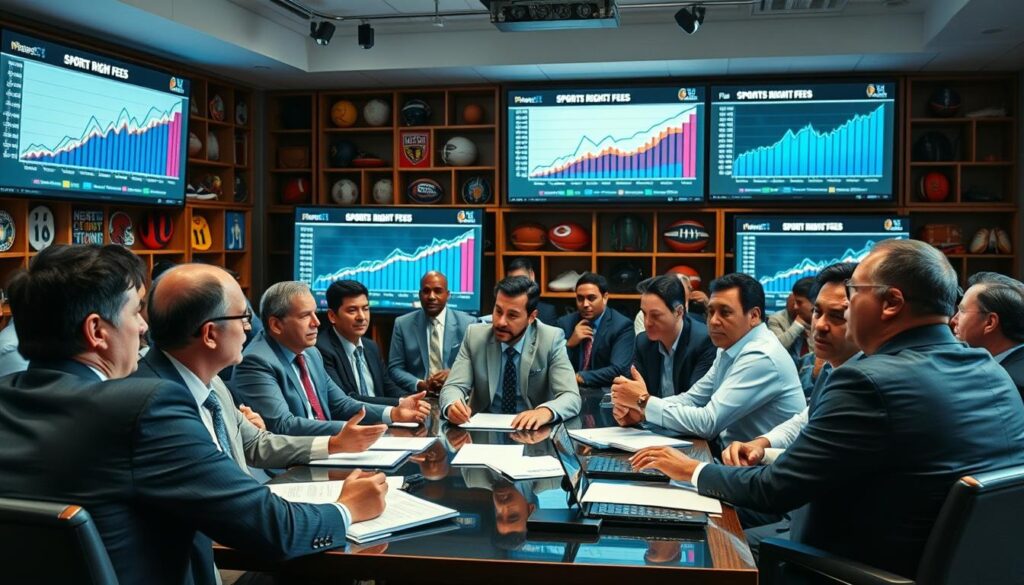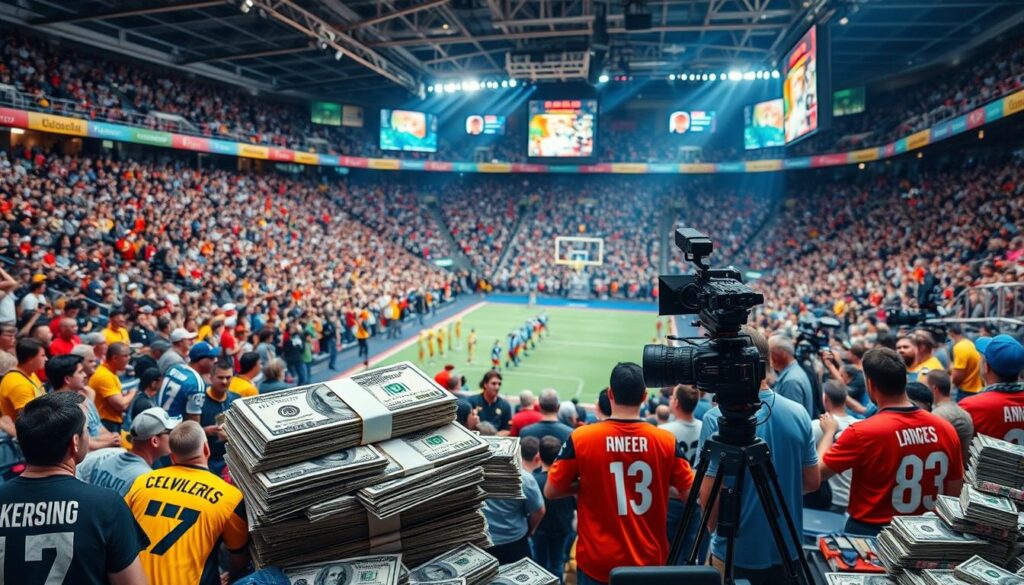“In the midst of chaos, there is also opportunity.” – Sun Tzu. This saying is very true for the sports media rights world in 2024. Big changes are coming, thanks to streaming services and new sports broadcasting deals. These changes will affect how much money is made and how networks will try to get your attention.
This article will give you a deep look into the sports media rights world. You’ll learn about the main factors and the fees that could change how you watch sports. With more NFL teams hiring international staff to make more money1, the fight for broadcasting rights is getting tougher. Get ready to see how these trends will shape the sports world in the coming year.
Overview of Sports Media Rights Landscape
The sports media rights landscape is a complex network of agreements. These media rights deals involve leagues, teams, broadcasters, and digital platforms. They shape the industry together.
With technology changing how we watch sports, broadcasters must adapt. They focus on delivering content digitally to meet viewer needs.
In 2024, the sports media rights landscape will see more competitive bidding and partnerships. This will affect prices and market positions2. Deals with big leagues like the NFL and NBA set industry standards. They impact both domestic and international markets.
Streaming platforms are becoming more popular, changing how we watch sports. Traditional media now compete with new services. This makes them rethink the value of media rights.
Understanding media rights deals is key for success in this competitive field. It helps stakeholders stay ahead.

| Year | Total Sales (in billions) | Retail Unit Sales | Average Selling Price |
|---|---|---|---|
| 2024 (Forecast) | $7 | 5.1% increase | $1,250 decline (5%) |
“The relationship between technology and sports media rights revenue becomes increasingly significant as new platforms enter the fray.” – Industry Expert.
The sports media rights landscape is changing fast. It’s driven by consumer demand for on-demand content and financial commitments from stakeholders. Each media rights deal reveals important sports industry trends. It’s crucial for industry players to stay informed and adapt quickly.
Key Drivers Influencing Media Rights Fees
In the world of sports, many things affect how much money is made from broadcasting games. One big factor is how people watch sports. Now, more people watch sports online, so TV stations must change to keep viewers and make money. This change shows how sports are moving towards being more accessible and engaging for fans.
The fame of sports leagues also plays a big role. Leagues like the NFL and NBA get a lot of money because they have many fans. But, leagues that are not as well-known might not get as much attention from TV stations. This shows how different sports are valued differently.
Money matters a lot too. TV ads bring in a lot of cash, and companies are willing to pay a lot to be part of sports shows. Also, TV stations are competing hard to get exclusive rights, which makes prices go up. Keeping up with these changes is important for anyone interested in sports broadcasting3.

Sports Media Rights Fees Trends 2024
The world of sports media rights fees is set for big changes in 2024. Leagues and networks are working on deals to grab more audience attention. These deals will change how we watch sports on different platforms.
Projected Increase in Fees
As more people want to watch sports, rights fees are expected to jump up in 2024. Big leagues are focusing on digital and international rights. This is key in today’s market.
The NFL, for example, is growing its global reach. More teams are boosting their international presence and making more money. This is thanks to specialized staff and more fans watching games1.
NFL games are getting more viewers, with 18.6 million watching this year. That’s a 10% increase from last season1.
Comparative Analysis with Previous Years
Looking at 2024 compared to before, we see a trend of higher fees. This is because how we watch sports is changing. More people are switching to online streaming.
Teams are also reaching out to fans worldwide. This shows they want to grow their audience beyond just home games4. More teams are hiring staff to help with this global growth1.

| Year | Average NFL Viewership (Millions) | Rights Fees Trends |
|---|---|---|
| 2021 | 17.1 | Stable |
| 2022 | 17.7 | Incremental Increase |
| 2023 | 16.9 | Decline |
| 2024 | 18.6 | Projected Significant Increase |
Impact of Streaming Services on Sports Broadcasting
The sports broadcasting world is changing fast thanks to streaming services. Sites like ESPN+, Amazon Prime, and Peacock are shaking up the old ways. They’re not just extra options anymore; they’re becoming the main places for sports fans to go.
Experts predict a 15% jump in sports media rights fees, thanks to streaming. This is because streaming services want to grab exclusive content. With digital sports content set to grow by 20%, traditional TV watching will drop by 10%. This shows fans are moving towards watching sports when they want to5.
Streaming services are spending big on media rights deals. This means more sports coverage for everyone. They’re not just showing live games; they’re also offering unique behind-the-scenes looks. As leagues and streaming sites team up, sponsorship money could jump by 25%, affecting media rights values5.
In the end, streaming services are changing how we watch sports. They’re moving towards flexible subscription plans. As our viewing habits change, streaming services will keep being key players in sports broadcasting.

Major Sports Broadcasting Contracts Set for Renewal
In 2024, big sports broadcasting deals will need to be renewed. This will change how sports are shown on TV and online. Networks and streaming services are getting ready to negotiate these deals.
Renewing these contracts will change how sports are broadcast in the US. It’s about money and how sports reach fans. Companies need smart plans to win these deals.
Good negotiations will set new rules for future deals. This is a key time for networks to adjust their plans. The results will decide who gets sports rights and set trends for years.
The table below shows the sports deals up for renewal in 2024 and their values:
| Sport | League | Current Broadcaster | Estimated Contract Value ($ billion) |
|---|---|---|---|
| Football | NFL | CBS, FOX, NBC | 10.0 |
| Basketball | NBA | ESPN, TNT | 24.0 |
| Baseball | MLB | ESPN, FOX | 3.0 |

As things change, everyone needs to watch for new trends. This is especially true as fans choose between TV and streaming6.
Trends in Sports Broadcasting Revenue
The world of sports broadcasting revenue is changing fast. This change is driven by many factors that make different leagues more profitable. By looking at how money is made from various sports leagues, we can find new chances for analysis and investment.
Revenue Streams from Different Sports Leagues
In 2024, sports media rights fees are expected to hit a record $20 billion. This shows the big money in this field7. Big sports leagues are fighting for huge deals to show their games on TV, proving live sports are key for broadcasters7.
Leagues are also looking into new ways to make money. They’re making original content and exploring other areas to make up for lost ad revenue. This change in how they make money is a big deal7.
Emerging Markets and Growth Potential
New markets are growing fast in sports broadcasting revenue. Digital streaming is set to take 30% of sports media rights fees, showing a big move to online watching7. As these markets grow, they open up new chances for advertisers and marketers to reach more people7.
With a 8% increase in revenue each year, these areas are becoming more important. They show that sports broadcasting is becoming a key source of profit7.

Significance of Sports Rights Negotiations
Sports rights negotiations are key in setting up how media rights fees are handled. They are vital for sports groups and broadcasters. They help set the financial base for future events and seasons. With changing media habits, getting exclusive content is now a big challenge, making deals more complex.
Utah State joining the Pac-12 shows the tough side of these talks. The move might cost the university tens of millions. It shows the big role money plays in these decisions8. The deal was seen as fair compared to others like Boise State and Fresno State. This highlights the need for talks that meet each school’s financial needs8.
These talks impact more than just the parties involved. They also shape the market. The Pac-12 and others like the Mountain West Conference are working on long-term deals8. It’s clear that clear and smart talks are key. Many want to protect their programs and find new chances for growth.

In today’s fast-changing sports world, understanding these negotiations is vital. The money from media rights can make or break leagues and teams. So, it’s important to carefully look at and plan for these negotiations.
The Role of International Markets in Media Rights Deals
In the fast-changing world of sports broadcasting, international markets play a big role. Local broadcasters face stiff competition from global platforms to get content that attracts more viewers. Events like the FIFA World Cup and the Olympics are huge hits worldwide, making them very profitable for broadcasters.
With the rise of online streaming, sports leagues can now reach more people. This opens up new chances to grow their fan base globally. By expanding into international markets, sports organizations can find new ways to make money.
These markets offer big financial gains and help sports leagues grow their fan base worldwide. Leagues now negotiate deals that include digital platforms for different regions. This way, they can reach more people and keep their brand strong globally.

As competition grows, negotiating media rights deals gets more complicated. Brands need to understand both local and global market trends. This balance is key to success in the sports broadcasting world.
By focusing on international markets, brands can see big gains. They need a strategy that meets local tastes and global trends. Remember, aligning fan engagement with international goals in media rights deals can benefit everyone in the sports broadcasting world9.
Predicting Sports Media Economics in 2024
The sports media world in 2024 will see big changes. These changes come from many factors and the way companies compete. Knowing these will help in making smart plans for media rights and broadcasting.
Factors Affecting Media Rights Value
Several key factors will shape the media rights value in 2024. How people watch sports is changing, moving towards streaming and on-demand. This shift is key for those looking to make the most of sports media rights.
New tech is also important, making watching sports more interactive and personal. This push for better viewing experiences can lead to higher prices for media rights. This boosts their value in the market.
Competitive Bidding Wars and Their Outcomes
As the demand for sports media rights grows, so do the bidding wars. With digital media rights fees expected to rise, companies will fight hard to get top sports events. This could lead to very high bids, changing how much money broadcasters and rights holders make10.
Looking at the future, we see a chance for higher fees overall. This means companies need to plan carefully to succeed. Those who do well could see big gains in their sports broadcasting revenue11.

In conclusion, knowing the sports media economics is key for everyone involved. By understanding trends like bidding wars, companies can make their way through the complex sports media rights market in 202412.
Future Outlook for Sports Broadcast Rights Trends
The future of sports broadcast rights is changing fast. New tech and ways to engage fans are leading the way. Big leagues are moving to sell directly to fans to make more money and connect better with viewers.
The NFL is a great example. They’re giving Super Bowl LXII to Mercedes-Benz Stadium in Atlanta. This shows their focus on big events and keeping fans interested1. The NFL also saw a 10% jump in viewers this season, reaching 18.6 million on average1.
Traditional media and new streaming services need to change to keep up. The NFL is expanding its reach globally, with teams like the Dolphins and Seahawks boosting their international branding1. Those who use their media rights well will likely see more fans and engagement.
As fans turn to new platforms, reaching a global audience is key. Ohio State’s success, like winning 56% of non-conference games, shows how sports data can draw viewers13. The future of sports broadcast rights will depend on how well these data insights are used to engage fans.

Challenges Facing Traditional Media Outlets
The sports media world is changing fast. Traditional media is facing big challenges. Viewership numbers are dropping, leading to less ad money. Digital platforms are also taking viewers away from TV.
These changes are hitting traditional media hard. They need to find new ways to make money. But, it’s tough because people want to watch sports when they want, not just on TV.
There are more problems than just viewership. The cost of sports rights is going up. This makes it hard for traditional media to stay afloat. They need new ideas to keep their audience and make money.

Impact of Economic Conditions on Sports Rights Fees
Economic conditions deeply affect sports rights fees. Changes in financial health influence how much broadcasters are willing to pay for sports content. Experts say that 2024 will see an increase in sports media rights fees, with advertising spending and consumer habits playing a big role14.
Understanding these economic trends is crucial. It helps stakeholders, especially during tough economic times when money is tight14.
As the economy changes, sports rights fees might shift a lot14. For example, North America’s growing media rights market means companies must quickly adapt to new trends15. Being able to adjust to economic changes can make a big difference for broadcasters15.
Knowing how economic conditions and sports rights fees interact is key for those in this field. As we get closer to 2024, the link between the economy and media rights values will grow stronger. It’s vital for organizations to use data to make smart decisions16.

